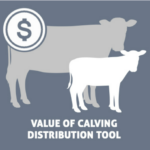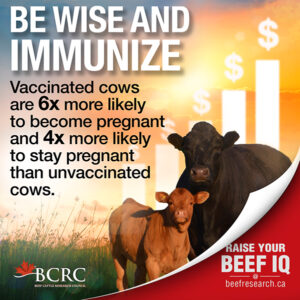Heifer Development
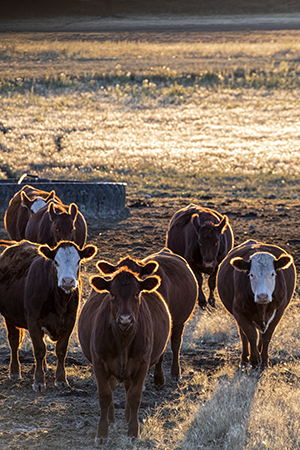
The management and development of heifers prior to breeding and before, during and after their first calving will set the tone for a female’s entire productive lifetime. Heifers require attention to ensure they are bred early, calve successfully and re-breed within an acceptable time to raise a calf each year. Whether producers retain females from within their own herds or purchase them, replacement heifers come at a cost and are an investment into the future herd. Selecting the right animals with proper management is necessary to meet on-farm goals and improve the longevity of the heifers as future breeding cows.
Replacement heifers are necessary on farm to:
- replace older or culled breeding cows,
- increase the herd size or rebuild following a herd reduction and
- improve the genetic and productive potential of the cow herd.
First-calf heifers are expected to breed, deliver and raise a calf and rebreed in a timely fashion, all while they are still growing. By implementing nutritional, breeding and herd health strategies specific to the growth and development of first- and second-calf heifers, producers can help to ensure that they will be productive breeding cows in the future.
| Key Points |
|---|
| Many producers retain their own heifers for reasons to maintaining control over herd genetics, to reduce the introduction of external diseases and to avoid the cash outlay required to purchase replacements. |
| Buying heifers from an external source provides the potential to purchase genetically superior heifers, can reduce the bull power needed (if purchasing bred heifers) and allows for the ability to grow the herd or change breeding programs more quickly, without the cost and risk of raising heifers from weaning to breeding. |
| Both raising and buying replacement females come at a cost. It may make sense to purchase, retain, alternate or both raise and purchase, depending on market conditions and feed supplies. |
| Post-calving, first calf heifers need a high energy and protein diet (at least 62% Total Digestible Nutrients (TDN) and 11% Crude Protein (CP).) Feeding replacement heifers separately from the rest of the herd allows for a specific ration to support growing heifers and reduces resource competition between young heifers and mature cows. |
| Optimally, producers will calve bred heifers at around two years of age, which means heifers need to be cycling by 11-14 months of age. Ensuring appropriate growth and body weight can be key to having heifers reach puberty on time. |
| Maintaining an optimum body condition score (BCS) of 3.0 is a valuable way to maximize the reproductive momentum of a beef producer’s entire herd, including replacement heifers. |
| Breeding heifers to calve early in the calving season, or prior to the main cow herd, can allow the heifers to have enough time to recover from calving and resume cycling before the next breeding season starts. |
| First- and second-calf heifers that have problems at calving are less likely to rebreed and birth a live calf during the next calving season. |
| Implement vaccination protocols and disease prevention strategies in consultation with a veterinarian. Most veterinarians recommend, at minimum, a modified live pre-breeding vaccine for infectious bovine rhinotracheitis/bovine viral diarrhea (IBR/BVD) for heifers. |
| When purchasing replacements, producers should buy from a known and reputable source with good health and a good vaccination program. |
| Consider working with a veterinarian to develop a standard biosecurity protocol for purchased cattle. |
Retaining or Buying Heifers – Costs and Benefits
Recent data from producer surveys indicates there is a great variation among herds regarding heifer performance, including pregnancy rates and calf loss. There presents an opportunity for improvement in the management and development of heifers in Canadian beef herds1.
Whether producers choose to purchase heifers or retain replacement females from within their own herd, developing heifers costs money. Every farm has different resources, such as available feed and facilities, and producers also have different operational goals. There are advantages and challenges with both options. The decision to raise or buy heifers is unique to each farm and can also vary from one year to the next.
Retaining Replacement Heifers
Why retain replacement heifers?
- Maintain control and consistency over the genetic makeup of the herd
- Lower up-front cash costs
- Rebuild herd using existing resources
- It may be more economical, considering market conditions
- Heifers may be better adapted to their production environment
- Reduce biosecurity risk by avoiding bringing potential diseases or pests from outside sources
While retaining heifers may require a lower up-front “cash” cost, there is still a substantial cost to retaining heifers. There is an opportunity cost, which is the revenue that a producer foregoes from a weaned heifer calf when she is retained rather than sold. A heifer’s value as a weaned calf accounts for an estimated 60% of her development costs. There are additional cash costs of post-weaning winter feeding (i.e., forage, grain, mineral, bedding, yardage), grazing, herd health (i.e. vaccination, parasite control, pregnancy detection) and breeding (the cost of a herd sire or artificial insemination). Finally, heifers that are open and any potential death loss also have to be factored in.
How many calves does a retained heifer need to raise in order to fully pay off her development costs?
This depends on the opportunity cost of those weaned heifers and the subsequent seasons’ calf prices as she becomes a productive female weaning her first few calves. Based on assessing ten years of prices, on average, a heifer needed to wean six calves in order to recoup her development costs during that time frame. This will vary with calf prices and cost of production which differs widely according to region and individual operation.
Buying Replacement Heifers
Why buy replacement heifers?
- Introduce new genetics
- Allow for rapid herd expansion
- Quickly change a breeding program
- Depending on calf prices and cost of production, it may be more economical
- It may free up resources such as bull power, feed, grazing or pen space at certain times of the year
- Avoid post-weaning health issues, death loss risk or other risks that may occur between weaning and breeding
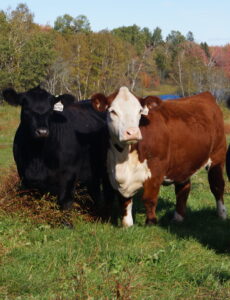
Buying heifers does come with some risks. There is a large cash outlay required to purchase replacements annually, which will vary depending on bred heifer prices that year.
When producers integrate new animals into their herd, there can be biosecurity concerns and a risk of disease introduction which may be significant depending on the source of the animals. As well, it can be difficult to predict how purchased animals will perform in a new environment or react to a different management system.
There are some important performance and biosecurity considerations:
- What is the vaccination status and history of replacement heifers in particular?
- What is the overall herd health program from the herd of origin? How are parasites and other animal health parameters managed?
- What type of management have the heifers been raised in and how does that align with their new herd? Are they used to being fed in pens or foraging in pastures? Are they accustomed to creep or supplemental feed?
- Are new heifers familiar with your stock water source (i.e., trough or water bowl or open access)?
- Evaluate disposition and conformation when bringing new animals in to a herd to make sure they align with your goals. Any potential problems that appear when an animal is young may amplify as they get older.
- Understand the practical realities of developing replacement heifers. Is there anyone on-farm with experience managing heifers post-weaning? Is the operation prepared to deal with potential disease outbreaks or nutritional challenges?
How to Choose between Raising and Purchasing Replacements
When considering whether to retain or buy replacements, it can be helpful to:
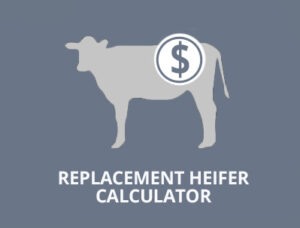
- Evaluate the goals of a heifer development program. What is motivating this interest (i.e., expansion, genetic improvement, replacing culls)? How will retaining or purchasing replacement heifers fit in with current herd management?
- Determine the economic value of replacement heifers entering the herd.
- Consider the financial risk. How will this impact cash flow? Is the operation financially prepared to weather the potential opportunity cost as well as cash costs of developing or purchasing replacement heifers? How many calves would heifers need to wean before they are profitable?
- Examine and be open to different options. This can be an opportunity for producers to challenge their way of thinking and use different strategies depending on their operational goals or yearly market conditions.
- Understand the realities of developing replacement heifers. Is there experience with managing heifers post-weaning? Is the operation prepared to deal with potential disease outbreaks or nutritional challenges?
- Identify biosecurity concerns prior to adding purchased replacement heifers into a herd. What factors need to be identified and mitigated? What needs to be done to protect the existing herd?
This webinar discusses the economics and management of replacement heifers. Learn about the benefits of buying heifers (at 18:46 and the advantages of retaining heifers (at 19:44). Examine the cash and opportunity costs (at 21:43) and understand the importance of establishing breeding momentum (at 53:27).
Nutrition, Puberty and Body Condition
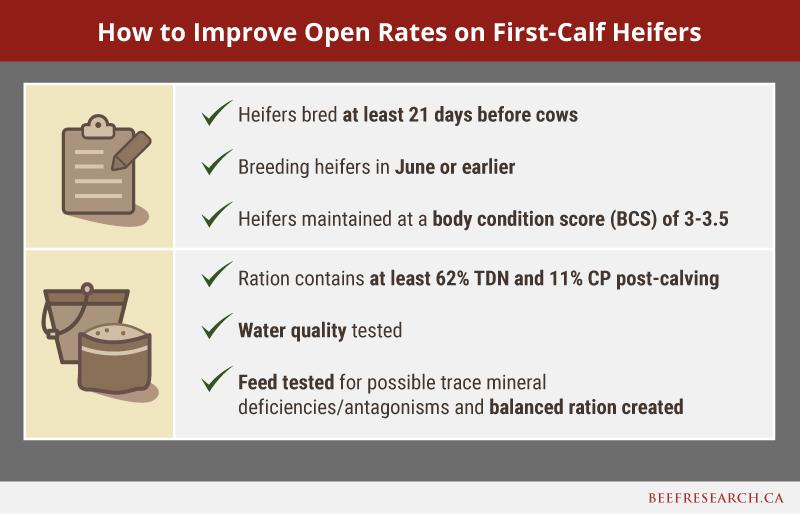
Nutrition
Nutrition affects almost every aspect of a replacement heifer’s success, from her reproductive momentum to her health status.
Compared to cows, heifers are still growing and therefore are more vulnerable to nutritional challenges including protein or energy deficits or trace mineral deficiencies.
The energy and protein demand of a heifer are 10 to 20 per cent more than those of mature cows, yet they are only physically able to consume about 80% as much dry matter compared to mature cows2. As heifers approach calving, fetal growth reduces a heifer’s daily feed intake by up to 17 per cent, which further emphasizes the importance of providing a high-quality, energy dense ration for this group of females2.
HOW DO OTHER PRODUCERS MANAGE HEIFERS?
This Saskatchewan farm has synchronized their heifers to calve in an intense, but short, time period while managing the challenge of calving them in a remote location.
These provincial Environmental Stewardship Award winners pushed their calving season back, but still calve their heifers ahead of the main herd.
This BCRC Council member uses a strategic tagging system to streamline heifer retention from within their own herd.
Producers from Alberta, Manitoba and Ontario all optimize nutrition for their heifers, but they take different approaches.
Feeding replacement heifers separately from the rest of the herd is a valuable management practice that can allow for specialized supplementation and avoids wasting money by overfeeding mature cows to meet first-calf heifer nutritional requirements. As well, it will reduce competition from mature cows, who tend to be more aggressive at the feed bunk or in extended grazing situations and outcompete younger cows for the highest quality feed.
Some producers may choose to winter feed their bred heifers along with their main cow herd in order to facilitate their adaptation to individual operation wintering practices. While a “survival of the fittest” approach to heifer management may work on some operations, every cull cycle leaves dollars on the table. As well, western Canadian herd surveillance data demonstrates that on average, heifers have a higher open rate at 9.7% compared to cows at 6.8% and across herds, there is much greater variability in heifer non-pregnancy rates than in cows3. Despite this wider variation among heifers, heifers will have similar pregnancy rates to mature cattle 50% of the time1. Providing heifers with targeted nutritional management may pay off in re-breeding potential.
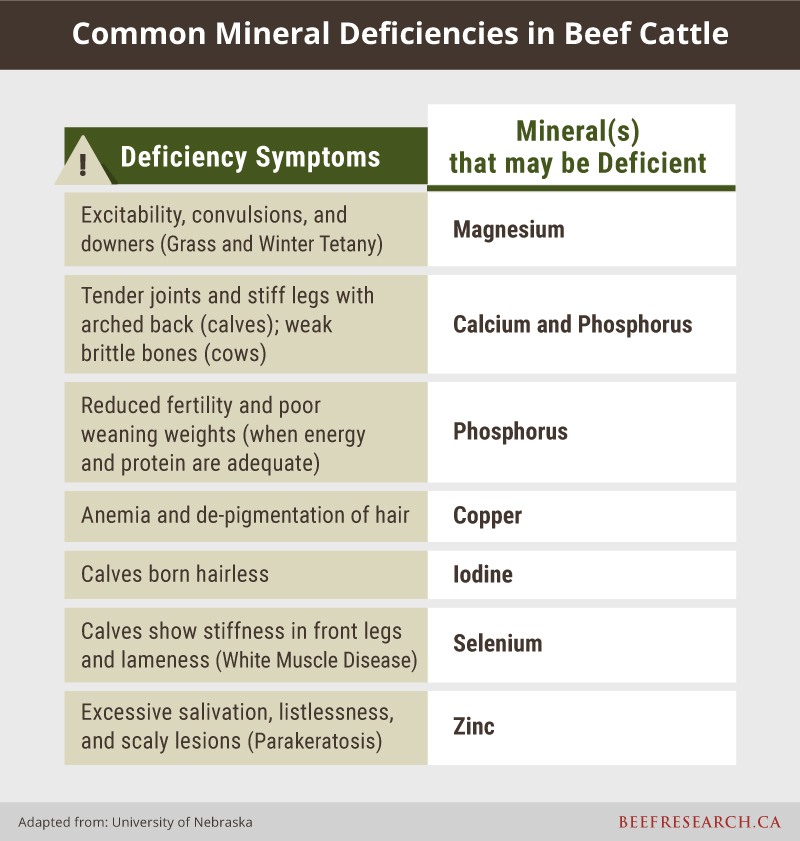
Post-calving, first calf heifers need a high energy and protein diet (at least 62% Total Digestible Nutrients (TDN) and 11% Crude Protein (CP),) which is unlikely achieved with a forage-based diet or early-season grass alone without some form of supplementation. Feed testing is the only reliable way to determine feed quality and any nutrient deficiencies. Heifers are more susceptible to nutrient deficiencies compared to mature cows as they are still growing. This is especially true for low copper levels in first time calvers.
Testing also allows you to strategically feed by providing lower quality feed during gestation when nutrient requirements are lower in the production cycle (i.e., during gestation) and saving the higher quality feed for calving and rebreeding when nutrient requirements are higher. Poor water quality can also have a negative impact on performance and potentially amplify nutrient deficiencies.
Puberty
Many producers plan to calve bred heifers by two years of age, which means heifers need to be cycling by 11-14 months of age. Weight, age and breed are highly important factors that determine the onset of puberty. Some heifers will cycle at 55% of their mature body weight while others need to be at 65% to cycle.

The target body weight at breeding can impact cost of production for replacement heifers. The traditional “Rule of Thumb” that suggested developing heifers to 65% of their mature body weight by first breeding may have been largely a factor of breed, as subsequent research has shown that feeding heifers to a lower mature body weight of 50-55% may still result in acceptable reproductive performance.
Many Canadian producers have been shifting from drylot pen feeding to extensive wintering (or in-field feeding) practices for beef cattle, including replacement heifers. Wintering heifers extensively on swath grazing or bale grazing can lead to lower post-wean gains of 1.1 lb per head per day which would allow heifers to reach 50-55% of their mature body weight at the time of first breeding. Research has shown that this can save money on winter feed costs without compromising the health and welfare of the animal or reducing reproductive performance4. However, this practice may not work on all farms and can come with trade-offs, including potentially lower conception rates due to fewer heifers cycling at the beginning of a breeding season2.
Prior to breeding, producers may consider having their veterinarian palpate heifers to determine if they are cycling, assess weight and condition and identify flaws, such as a narrow pelvis.
A compilation of Canada-wide long-term survey results demonstrates that industry standard conception rates are approximately 94% for cows and 92% for heifers. Recent survey data analysis identified additional risk factors for non-pregnancy in heifers compared to cows1. This includes herds that breed heifers in July or August (compared to June or earlier), and large herds (greater than 300 females) had lower pregnancy rates than study counterparts.
If open rates in a breeding heifer herd are greater than 8%, it is worth investigating additional causes with a veterinarian. Forage and water quality, health status of the heifers, insect pressure, breeding bull soundness, venereal diseases, mineral status, nutrition and body condition scores can all impact a heifer’s ability to conceive.
Early pregnancy detection in heifers may also be a useful practice to adopt, providing producers with an opportunity to sell open heifers on the yearling market and to reduce additional feeding, grazing or veterinary expenses.
Body condition
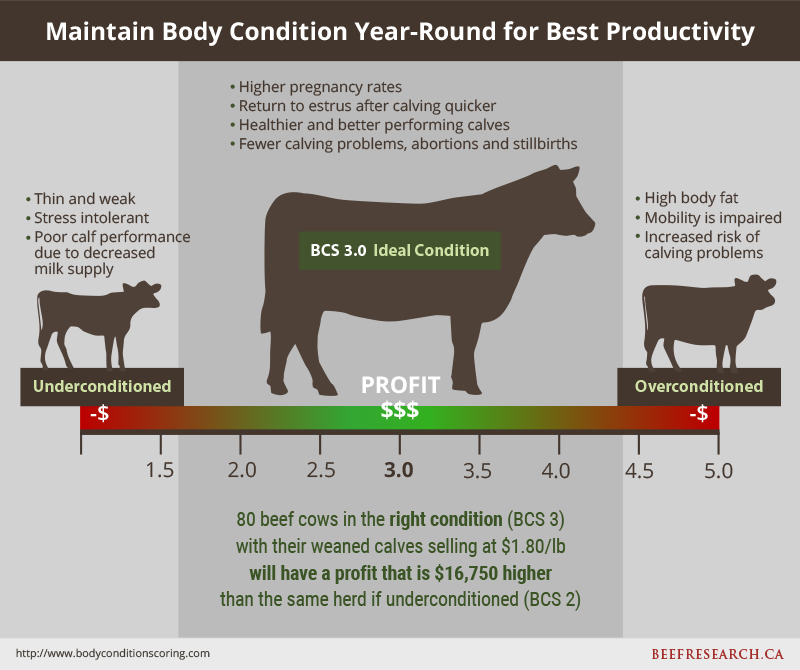
One method of assessing nutritional well-being is to perform a body condition score (BCS). Maintaining the optimum BCS of 3.0 is a valuable way to maximize the reproductive momentum of a beef producer’s entire herd, including replacement heifers. Research shows that first calf heifers with a BCS of 3 at calving had pregnancy rates over 90% in the next breeding. Heifers with a BCS less than 3 at calving, had subsequent pregnancy rates below 70%.
Maintaining optimal BCS has other benefits such as:
- minimizing time to rebreed,
- decreased risk of abortion and calf death at or near birth,
- fewer calving problems (very thin and very fat cows at are at a higher risk of calving difficulties) and
- sustaining adequate milk and colostrum production.
Breeding Management and Momentum
Establishing breeding momentum is key to ensuring heifers re-breed within an acceptable amount of time following the delivery of their first calf. Given that a heifer must typically wean five to six calves to recoup development costs, it is critical for producers to focus on breeding and health management of replacements in order to give the heifer a chance to pay back her development costs.
Timing of Breeding
While it only takes mature cows 50-60 days to return to estrus post-calving, it naturally takes heifers 80-100 days to resume cycling post-calving. In order to reduce the amount of open or non-bred heifers, producers may want to consider breeding their heifers to calve before the main cow herd.
Breeding heifers to calve early in the calving season will help to ensure the heifers have enough time to recover from calving and resume cycling before the next breeding season starts. This can help the cow herd maintain reproductive momentum and longevity and can result in a more condensed calving distribution with more calves born in the first cycle, rather than in the second or third cycle. Calves born early in the calving season will have an age and weight advantage over their later-born counterparts.
“Front-loading” the calving season, by ensuring 65% of their breeding herd is bred and calves in the first 21 to 30 days (i.e., first cycle), results in heavier calves and a shorter breeding season. This can also translate to a more uniform calf crop and subsequent profit potential.
Breeding heifers prior to cows also allows heifers has disease prevention and labour benefits. Heifers are more likely to have dystocia or mismothering issues, and their calves may be at a higher risk of failing to get adequate colostrum, which can lead to problems such as an increased risk of infectious disease. Calving heifers before the main cow herd can help producers focus their efforts during calving season on the group with the highest risk of problems, while also allowing those calves to be born in a cleaner, less contaminated environment.
Producers may wish to achieve early breeding by having a concise, defined breeding season of 42-45 days for heifers.
Value of Calving Distribution Calculator
The BCRC’s Value of Calving Distribution Calculator allows producers to see what their current calving distribution is and what the short-term economic benefit would be if they move to an industry target of 60-25-10-5 or a breeding season of three cycles.
Bull Power
When breeding first and second calf heifers, a breeding soundness exam can ensure that bulls are semen tested, fertile and free from injury or disease. An appropriate bull to heifer ratio will help to achieve maximum reproductive potential in replacement heifers. It is also important to consider using bulls selected for lower birth weights (BW) and calving ease, whether this is through natural breeding or artificial insemination.
Increased vigilance is required regarding bull management when retaining replacements. When breeding bulls back to heifers retained from the same herd, each generation poses an increased risk of inbreeding and genetic defects.
Preventing Calving Difficulties
Heifers can be at a higher risk for dystocia, compared to their mature cow counterparts. Females, especially first and second calf heifers, that experience calving difficulty are less likely to rebreed during the next calving season. Using calving records to identify potential problem females can be a valuable tool.
Selection of bulls with better calving ease EPD’s to minimize calving difficulties has the added benefit of minimizing other impacts on fertility. Cows where fetal manipulation due to a malpresentation or a Caesarean section was performed are less likely to be pregnant the following year. Similarly, cows that abort or lose their calf at birth or within the first few hours from birth are more likely to be open after the next breeding season5. Thin or excessively over-conditioned cows are also more likely to have problems at calving.
Heifer Health Management
Heifers may have lower levels of immunity and be more susceptible to infectious diseases and nutritional challenges. It’s important to understand common disease pressures on your operation and use preventive measures such as vaccinations and biosecurity protocols to optimize herd health.
Disease Prevention
When considering a disease prevention (e.g., vaccination) or treatment program on-farm, it is important to have a well-established Vet-Client-Patient-Relationship (VCPR). If a vet is familiar with a herd and operation, it allows them to provide specific veterinary recommendations for reoccurring issues or an operational goal. Implement vaccination protocols and disease prevention strategies in consultation with a veterinarian. Vaccination not only protects replacement heifers from known diseases on farm but can also prevent an outbreak from purchased replacements spreading to the main herd.
Producers should consider vaccination for known disease that can negatively impact reproductive efficiency like Bovine Viral Diarrhea (BVD) and Infectious Bovine Rhinotracheitis virus (IBR). Most veterinarians recommend heifers be administered with a modified live IBR/BVD pre-breeding vaccine. If producers choose to raise their own replacements, a good vaccination protocol for the bred cow herd can also help set up calves for success in utero.
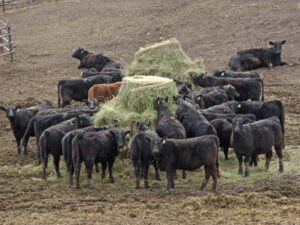
Venereal diseases, such as trichomoniasis and vibrio, can be spread from one female to another through bull breeding. While these diseases occur infrequently, their impact can be devastating and result in low conception rates, embryonic loss, early abortions and temporary infertility. Discuss vaccination protocols with your veterinarian.
While prevention is important step, having established treatment protocols in consultation with your veterinarian can result in timely action and prevent the spread and progress of disease before it becomes critical.
Parasite Management
Provide appropriate external parasite control for replacement heifers from weaning through breeding. Parasite management strategies, like alternating the use of products with different modes of action and using products at the correct dose for heifers, can ensure that parasite prevention and treatment methods remain effective.
As well, cattle under the age of two usually have the highest internal parasite burdens. Consult your veterinarian to determine if a spring application of an internal parasite control product is warranted.
Biosecurity
Biosecurity can be compromised by purchased bulls and replacement heifers. Employ proper biosecurity protocols to prevent introduction of diseases before, during and after breeding heifers. The most effective method of biosecurity is having a closed herd, although a true “closed herd” is almost impossible considering fence-line contact, purchased breeding stock and interactions with farm visitors and wildlife.
Remember when bringing in replacements, producers should buy from a known and reputable source with good health and a comprehensive vaccination program. Try to limit the number of sources of replacements and isolate replacement animals in a separate pen/water source prior to introducing them to the rest of the herd.
When buying heifers from a source with an unknown history, consult your veterinarian to determine tests, specific isolation measures and vaccination protocols to protect the existing herd from many diseases. For diseases such as Johne’s disease, the only mitigation method is to ensure the replacement source herd is not infected with Johne’s.
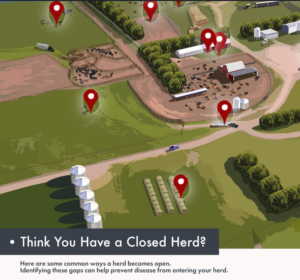
Record-Keeping

Cattle records are unique to individual farms. Keeping accurate records for replacement heifers is a valuable management practice to inform producers on nutritional status, herd health, pregnancy detection results, breeding information, calving distribution and source information. Producers looking to retain heifers may make notes or identify potential replacements as weaning approaches. Using on-farm data and benchmarks can help producers track their progress and identify whether they are meeting the goals of their heifer replacement program as well as target areas to improve.
Developing replacement females is critical to the long-term success, profit and production of a cow herd. Choosing replacements carefully, whether it is from within your own herd or an external source, will help optimize your investment.
- REFERENCES
-
1. Waldner, C., Parker, S., and Campbell, J. 2019. Identifying performance benchmarks and determinants for reproductive performance and calf survival using a longitudinal field study of cow-calf herds in western Canada. PLOS ONE 14(11). Available here.
2. Beef Cattle Research Council Staff. November 12, 2019. Improve Your Profits by Lowering Open Rates in First Calf Heifers. BCRC Blog. Available here.
3. Canfax Research Services. 2025. Canadian Cow-Calf Adoption Rates and Performance Levels Report. Edited by: Trautman, D., Rivera, C. S., Waldner, C., Schmid K., Larson, K., Jelinski, M., Bergen, R., Domolewski S., Herbert, T., Irvine, M., Fortier, S., Thompson, K., Crane, E., et al. Funded by the Beef Cattle Research Council. Available here.
4. Lardner, H., Damiran, D., Hendrick, S., Larson, K., and Funston, R. 2014. Effect of development on growth and reproductive performance of beef heifers. West Central Research and Extension Center, North Platte. 87. Available here.
5. Waldner CL, Garcia Guerra A. 2013. Cow attributes, herd management, and reproductive history events associated with the risk of nonpregnancy in cow-calf herds in Western Canada. Therio Volume 79:1083-94. Available here.
Feedback
Feedback and questions on the content of this page are welcome. Please e-mail us at info@beefresearch.ca.
Acknowledgements
Thanks to Dr. John Campbell, Western College of Veterinary Medicine, and Karin Schmid, Beef Production and Extension Lead with Alberta Beef Producers, for contributing their time and expertise to reviewing this page.
Ce contenu a été révisé pour la dernière fois en Octobre 2025.

